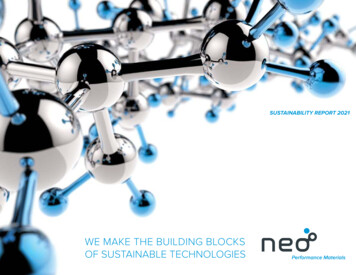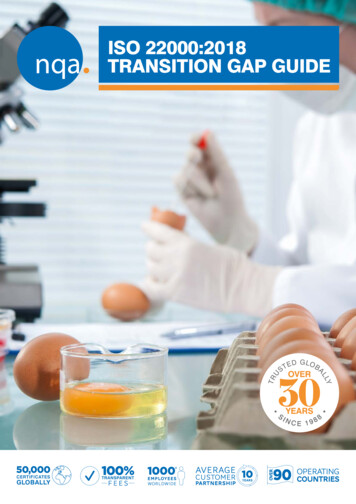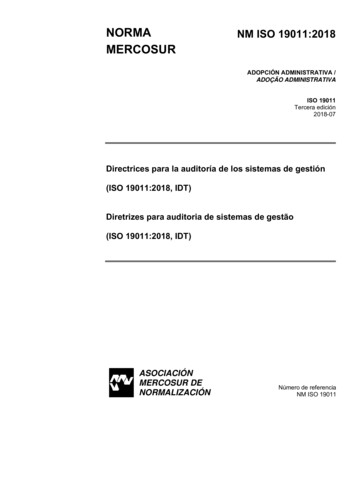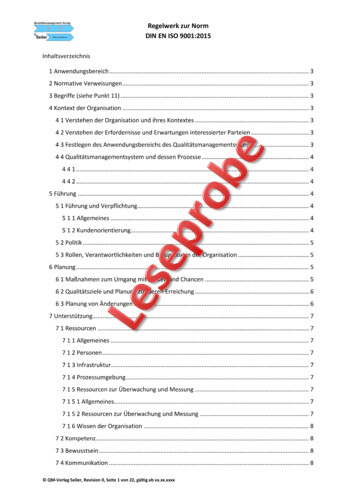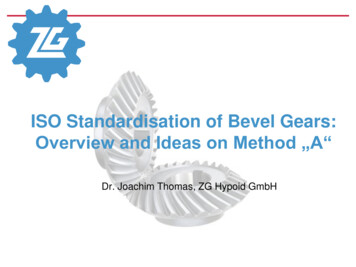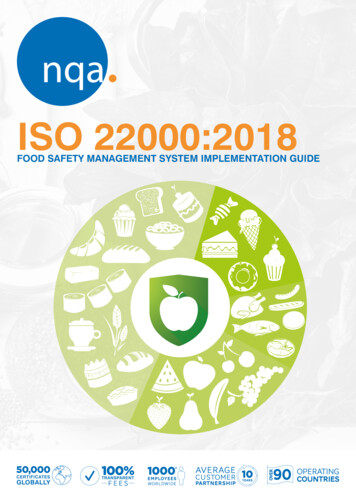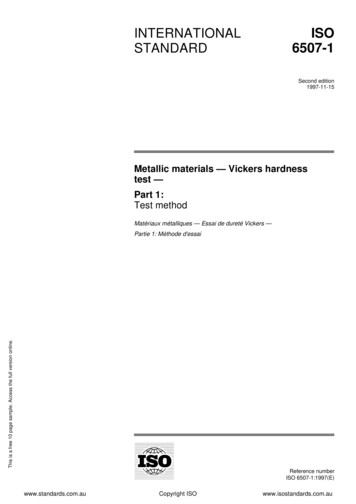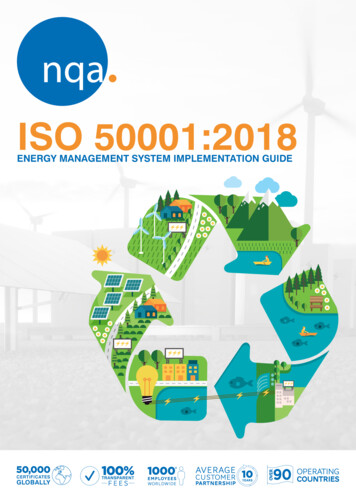
Transcription
ISO 50001:2018ENERGY MANAGEMENT SYSTEM IMPLEMENTATION GUIDE50,000CERTIFICATESGLOBALLYTRANSPARENT90
ISO 50001:2018IMPLEMENTATION GUIDE2ISO 50001:2018 IMPLEMENTATION GUIDE
ContentsIntroduction to the standardP04Benefits of implementationP05Annex SLP06PDCA cycleP07Risk based thinking / auditsP08Process based thinking / auditP09SECTION 1: ScopeP10SECTION 2: Normative referencesP10SECTION 3: Terms and definitionsP11SECTION 4: Context of the organizationP12SECTION 5: LeadershipP14SECTION 6: PlanningP16SECTION 7: SupportP20SECTION 8: OperationP22SECTION 9: Performance evaluationP24SECTION 10: ImprovementP28Get the most from your management systemsP29Energy Management TrainingP30Next steps once implementedP32Useful linksP36ISO 50001:2018 IMPLEMENTATION GUIDE3
INTRODUCTIONTO THE STANDARDBS EN ISO 50001:2018 “Energy management systems – Requirements with guidance foruse” sets out an energy management framework for establishing policies, processes,procedures and specific energy-tasks to meet an organization’s energy objectives. Itrequires an organization to define its desired energy performance, and work towardsachieving its stated objective(s).As with other ISO management system standards, the energymanagement system (EnMS) in ISO 50001 is based on the“Plan, Do, Check and Act” framework. It was first published inJune 2011 and updated in August 2018.Brief history of ISO 50001The United Nations Industrial Development Organization(UNIDO) recognised that industry around the world needed tomount an effective response to climate change. It also noteda proliferation of national energy management standardsincluding ones developed in China, Denmark, Ireland, Japan,Republic of Korea, Netherlands, Sweden, Thailand, USA andthe European Union as a response to market demand for helpwith energy efficiency. In April 2007, a UNIDO stakeholdersmeeting decided to ask ISO to develop an international energymanagement standard. ISO had identified energy managementas one of its top five areas for the development of InternationalStandards and, in 2008, created a project committee, ISO/PC242 “Energy management”, to carry out the work.4ISO 50001:2018 IMPLEMENTATION GUIDEISO/PC 242 was led by ISO members for the United States andBrazil. In addition, its leadership included the ISO members forChina and the United Kingdom to ensure that developed anddeveloping economies participated together in the strategicdirection and administration of the project committee. It wastransformed into a technical committee in June 2011, signifyingthat it would be developing additional standards.Experts from the national standards bodies of 44 ISOmember countries participated and another 14 countries wereobservers. Development organizations including UNIDO andthe World Energy Council (WEC) were also involved.In 2012, the Lawrence D. Eicher (LDE) Leadership Award forexcellence in creative and innovative standards developmentwent to the ISO/TC 242 technical committee for the work thatwas carried out to publish the Standard in June 2011. At thetime, it was estimated that the Standard could influence up to60% of the world’s energy use.
BENEFITS OFIMPLEMENTATIONWhilst having a thought-out system to manage business processes are beneficial, there arespecific benefits of implementing an EnMS which is certified to ISO 50001:A FRAMEWORK TO MANAGE ENERGYBENCHMARKINGAn effective EnMS that is aligned with an organization’sbusiness strategy, will allow visibility of how energyis being used and areas where performance can beimproved. It provides the structured policies, processes,procedures and action plans to implement energysaving opportunities. Continual improvement in energymanagement is therefore achieved.ISO 50001 requires an organization to establish abaseline to act as an indicator of energy performance.By identifying a baseline, energy efficiency can betracked over time.COST REDUCTIONAny energy reductions identified through an EnMS will,in turn, offer demonstrable savings on energy bills,which will reduce the overhead of a business and insome cases substantially. There are many examplesof an organization undertaking the ISO 50001 processachieving first year energy cost savings which are equalto or greater than the initial costs of implementing theStandard.REDUCING ENERGYCost reduction as identified in b) above and reducingenergy, go hand in hand. By establishing, implementing,maintaining and continually improving an EnMS, anorganization will be able to not only deal with the initialenergy saving opportunities or “low-hanging fruit” butto identify and manage where, when and how energyis being consumed and identify energy efficiencyimprovements and reductions.CARBON REDUCTIONMany businesses report their output of carbon dioxide(CO2) or “carbon footprint”. Whilst CO2 reductioncannot really be cited as a primary reason for achievingthe ISO 50001 Standard, any reductions in energy willhave a direct correlation with an organization’s overallcarbon footprint.ORGANIZATIONAL ENGAGEMENTThe “top down” approach within ISO 50001 ensuresthat key senior stakeholders within the organizationunderstand,as appropriate, its EnMS and are thereforemotivated to achieve its objectives. ISO 50001can be also be used to drive engagement on energymanagement; providing other members of anorganization with a structured approach to managingenergy use.REGULATORY COMPLIANCESimilar to ISO 14001 and ISO 45001, ISO 50001requires an organization to identify and have access toapplicable “legal and other requirements” in relation toits energy efficiency, energy use, energy consumptionand its EnMS.In the UK, ISO 50001 can be used to comply directlywith the Energy Savings Opportunity Scheme (ESOS).The Government established ESOS to implement Article8 (4 to 6) of the EU Energy Efficiency Directive (2012/27/EU). In general ESOS applies to large UK undertakingsand their corporate groups. It mainly affects businessesbut can also apply to not-for-profit bodies and any othernon public sector undertakings that are large enough tomeet the qualification criteria.Organizations are required under ESOS to reviewthe total energy use and energy efficiency of theorganization and identify cost-effective energy savingsopportunities by undertaking an energy audit. However,if an organization has an EnMS certified to ISO 50001then upon registration of the certification with theEnvironment Agency, direct compliance with ESOS isachieved.REPUTATIONAchieving ISO 50001 can offer significant reputationalbenefits by demonstrating to an organization’sstakeholders that it is fully committed to managing itsenergy consumption and seeking ways to increase itsenergy efficiency.When an organization gains certification, it can displaythe NQA logos on appropriate materials (in accordancewith NQA/UKAS guidelines). This can not only publicisean organization’s credentials (and perhaps provide acompetitive edge) but can provide a short-hand infographic that energy “governance” is being achieved.COMMERCIALITYIt is an ever increasing trend, that when seeking tosupply goods and services to the business sector(particularly the Public Sector) accredited systems suchas ISO 50001 are required, in order to meet pre contractprocurement award criteria.ISO 50001:2018 IMPLEMENTATION GUIDE5
ANNEX SLAnnex SL provides the new common architecture for ISO Management System Standards.It replaces ISO’s Guide 83, which provided a structure and text for management systemstandards. Guide 83 started to address the issues that many organizations had whenintegrating such Standards as ISO 9001, ISO 14001, ISO 27001 and ISO 50001.Annex SL takes the principles within Guide 83 and creates auniversal high-level structure, identical core text, and commonterms and definitions for all management system standardswhich make the integration of management systems whenaccording to a particular Standard easier.Note: the “SL” in Annex SL doesn’t stand for anything– it’s just the way that ISO identifies things!A good use of Annex SL and an example of an integratedmanagement system (IMS) is one that simultaneously handlesthe requirements of ISO 9001, ISO 14001 and ISO 50001.Typically, the processes required in each Standard for documentcontrol, internal audits, dealing with nonconformities, correctiveactions, or management review are shared, so that therequirements of each Standard are met without duplicating efforti.e. having three processes - one for ISO 9001, ISO 14001 andISO 50001.High level structureAnnex SL high level structure comprisesthe following:1.2.3.4.5.6.7.8.9.10.ScopeNormative referencesTerms and definitionsContext of the ormance evaluationImprovementClauses 1 to 3 provide a background to the Standarditself and it is not until clause 4 that the requirements ofthe Standard are set out.Whilst clauses 4 to 10 are common to all ManagementSystem Standards, ISO 50001 specifically relates toenergy topics. So, whilst there is commonality, thereare processes to be established, implemented andmaintained such as an energy policy and undertakingan energy review which are unique to ISO 50001.6ISO 50001:2018 IMPLEMENTATION GUIDE
PDCA CYCLEPlan-Do-Check-Act (PDCA) is an iterative, four-stage approach for achieving continualimprovement. It involves systematically testing possible solutions, assessing the results,and implementing the ones that are shown to work. At the “heart” of this approach isleadership. The importance of leadership at all levels, but particularly by Top Management,cannot be underestimated to operate an EnMS successfully, to achieve performance levelsrequired and generate continual improvement.In the context of an EMS, PDCA is translated into the following:Plan:Understand the context of the organization,establish an energy policy, understandrisks and opportunities and undertake anenergy review by gathering, analysingand interpreting energy data. This energyintelligence is then used to help set trends,Significant Energy Uses (SEU’s), energybaseline(s) performance indicators,objectives, targets and actions. It is alsocritical to secure Top Management buy-inand identify where help from competentconsultants is required as well as securingNQA as a preferred ISO 50001 certificationprovider.Do:Implement the energy management actionplans and act on the analysis of energydata to drive new standards of energyperformance.Check:Monitor, measure, analyse, evaluate andaudit and conduct energy reviews of energyperformance against objectives and targets,then report the results.Context of the organizationINTERNAL ANDEXTERNAL ISSUESNEEDS AND EXPECTATIONSOF INTERESTED PARTIESSCOPE OF THE ENERGY MANAGEMENT SYSTEMPLANNINGPlanDoSUPPORT ONAct:This is where you take action, led from topmanagement level, to ensure continualimprovement in the EnMS and to addressnon conformity.INTENDED OUTCOMES OF THEENERGY MANAGEMENT SYSTEMSISO 50001:2018 IMPLEMENTATION GUIDE7
RISK BASEDTHINKING/AUDITSThe Plan-Do-Check-Act (PDCA) cycle for process improvement, as described above,corresponds to proven risk management approaches. Many organizations have the processof risk management as a fundamental process particularly around information technology,finance and occupational health and safety. The following identifies the key processes inISO 50001 where risk based thinking is inherent:Context:Planning – risk and opportunities:One of the first steps of implementing an EnMS, as describedbelow, is to gain an understanding of the “context” of theorganization or, paraphrasing, the macro issues that affect andare affected by an organization. For instance, this could besecurity of energy supply. As an organization is subject to avariety of influences, which can change, this can lead to risksin the form of potential threats and opportunities. Determiningthe risks that derive from this drives an organization to considersuch changes or events, analyse their impacts and chancesof an event occurring and then encouraging a planning ormitigation strategy.Those organizations that need further assistance in ensuringthat their risk assessment process is comprehensive canlook towards ISO 31000 Risk Management - Principles andguidelines. This provides generic guidelines although it is notintended to promote uniformity of risk management acrossorganizations. Of course, the design and implementation ofrisk management plans and frameworks will need to takeinto account the varying needs of a specific organization, itsparticular objectives, context, structure, operations, processes,functions, projects, products, services, or assets and specificpractices employed.Planning – legal and otherrequirements:Improvement – continualimprovement:The assessment of whether an organization is complying withtheir energy legal framework. The concept of maintainingknowledge and understanding of its compliance status hasbuilt in risk assessment principles so that an organization candetermine its compliance status and, per se, understand whereit is not complying and therefore devise strategies to minimisethe risk.A risk based philosophy means that an organization can bebetter prepared for the impacts of uncertainty e.g. stable powersupply, which in turn means greater resilience. Moreover, riskbased thinking implicitly results in continual improvement, asan organization is always examining potential influences andchanges. 8ISO 50001:2018 IMPLEMENTATION GUIDE
PROCESS BASEDTHINKING/AUDITSome organizations that implement an EnMS will look to integrate it with their Quality (QMS)or Environmental Management System (EMS). If this is the case, they will be familiar with“process based” thinking. However, if not, it might not be clear how the process approach isapplicable to the EnMS requirements in ISO 50001.The ISO 9001 requirements for a QMS arefounded on seven quality management principles,and one of these is the “process approach”. It isexplained fully in the introduction of ISO 9001, butas a paraphrased summation; a process approachis where more consistent results can be attainedwhen consideration and management of activitiesare carried out as interrelated processes, whichtogether, make up a system.The process approach applies to an EnMSbecause a comprehensive appreciation ofan organization’s energy use/consumption/equipment from its processes needs to be known.The following are the main areas in an EnMSwhere process thinking is attributable:Context:A comprehensive appreciation of an organization’s processesneeds to be understood when considering the macro issueswhich interrelate between the organization and energyconsumption.Energy review:In order to determine a comprehensive assessment of theenergy the current types and past and current energy useand consumption need to be analysed. This will draw outSignificant Energy Uses (SEUs).Performance and monitoring:In order to determine energy performance, analysis of energydata derived from the EnMS needs to be evaluated.Support/competence:In order to manage energy use/consumption, a person needsto be competent. When determining competence needs,competence will need to be obtained or matched to the needsof the particular energy using processes. If competence is notproven or appropriate to a particular process this could resultin breaching legal requirements or energy performance beingaffected.Internal audit:The processes which comprise the EnMS need to besystematically audited over a time and frequency to determinewhether they perform effectively.Corrective action:A corrective action is an opportunity to correct a problemidentified in an EnMS. A process approach to this will startat root cause and finish at an appropriate and satisfactorysustainable solution.ISO 50001:2018 IMPLEMENTATION GUIDE9
SECTION 1:SCOPEThere are no specific requirements foran organization to adhere to within thissection. However, it sets out the parameterswithin which ISO 50001 can be used andprovides the overall intended outcome of anEnMS as being: To enable an organization to follow asystematic approach in achieving continualimprovement of energy performance and theEnMS.The section also sets out that the Standard: Is applicable to any organization, type,size, complexity, geographical location,organizational culture or the products andservices it provides. Is applicable to activities affecting energyperformance that are managed andcontrolled by the organization. Is applicable irrespective of the quantity, use,or types of energy consumed. Requires demonstration of continual energyperformance improvement, but doesnot define levels of energy performanceimprovement to be achieved. Can be used independently, or be aligned orintegrated with other management systems.SECTION 2:NORMATIVEREFERENCESISO/IEC Directives, Part two, Section 6.2.2,defines the inclusion of a normative referenceas, “This conditional element [of the Standard]shall give a list of the referenced documents in such a way as to make them indispensable forthe application of the document.”In other words, by citing something as a normativereference, it is considered as indispensable to theapplication of that particular Standard. However, unlikeISO 9001, there are no normative references in ISO 50001.10ISO 50001:2018 IMPLEMENTATION GUIDE
SECTION 3:TERMS ANDDEFINITIONSThis section sets out the terms and definitions that are used in the Standard which may needfurther clarification in order to apply the Standard to a particular organization. They are listedaccording to the hierarchy of the concepts (reflecting the sequencing of their introduction inthe Standard).Terms are grouped by major clause title (i.e.Context of the Organization, Leadership,Planning, etc.). ISO/TC 207/SC 1/WG 5 agreed toorder terms within the groupings such that:i. discipline-specified terms are presented consecutively afterits generic form, and to the extent possible.ii. present terms in the order in which they appear in thetext. WG5 inserted an “Alphabetical index of terms”, whichmay be modified to reflect alphabetical listings in anotherlanguage.In addition to the term or definition there are also notes thatseek to provide further information and clarity.If an electronic version of the Standard has been purchasedthe definitions are hyperlinked to other definitions so that theirinterrelationship can be seen.The following sections, 4 to 10, provide the requirements ofthe Standard. When reading the Standard it is important thatas with the previous iteration of ISO 50001, the word “shall”indicates the mandatory requirements that an organizationmust meet and external auditors, such as NQA, are required toverify conformance and effectiveness against.In order to understand how each of the following clausesapplies to each other the remaining text applies to thefollowing diagram:PLAN4Context of theorganizationUnderstandingthe organizationand its context5LeadershipLeadership& commitment6PlanningActions toaddress risks& nce& g andcontrolCompetenceUnderstandingthe needs andexpectationsof interestedpartiesDeterminingthe scope ofthe EnMSEnergy PolicyOrganizationalroles,responsibilitiesand lysis andevaluationof energyperformanceand the EnMSNonconformityand correctiveactionContinualimprovementEvaluation ofcompliance withlegal and otherrequirementsInternal auditEnMSPlanning forcollection ofenergy dataManagementreviewISO 50001:2018 IMPLEMENTATION GUIDE11
SECTION 4:CONTEXT OF THEORGANIZATIONThis is a new concept in terms of ISO 50001:2018 which was introduced as part of the reformattingof management ISO’s using Annex SL. Of course, ISO 50001 had always asked to undertake acomprehensive review of energy within an organization but context “elevates” this to provide abroad understanding of energy use/consumption/requirements an organization has prior to workingout SEU’s or detailed energy performance.The clause is sequential as there is need to understand the organization and context (4.1), prior to identifying interested partiesand understanding their needs and expectations (4.2), the output of both 4.1 and 4.2 allows determination of scope (4.3), and thenultimately designing the EnMS (4.4):Clause 4.1Understanding theorganization and itscontextClause 4.2Understanding theneeds andexpectations ofinterested partiesClause 4.3Determining thescope ofthe EnMSClause 4.4EnergyManagementSystemUnderstanding the context of the organization is usually conducted by top management with information about the business andactivities gathered at every level of the organization. Discussion points focus on internal and external issues which have an impacton the EnMS system.4.1 U nderstanding of the organization and contextThe intent of “Context” is to provide a high-level, conceptual ofthe external and internal issues that can affect, either positivelyor negatively, energy performance and the EnMS of theorganization.To put it another way, it is a comprehensive appreciation of themacro processes (and their interrelation) which can affect or beaffected by an organization. From ISO 50001:2018 Annex A,it suggests that the following can be appreciated whenunderstanding “context”:External issuesInternal issues Issues related to interested parties such as existingnational or sector objectives, requirements or standards. Restrictions or limitations on energy supply, security andreliability. Energy costs or the availability of types of energy. Effects of weather. Effects of climate change; Effect on greenhouse gas (GHG) emissions. Core business objectives and strategy; Asset management plans; Financial resource (labour, financial, etc.) affectingthe organization; Energy management maturity and culture; Sustainability considerations; Contingency plans for interruptions in energy supply; Maturity of existing technology; Operational risks and liability considerations.There are a number of methodologies that can be used to determine context. A good way of achieving this is to formulate a matrixsetting out the requirements of the Standard (and Annex A) and then perform a series of interviews with appropriate employees, sothat the knowledge of an organization can be harnessed. Where appropriate, this could be turned into a report or perhaps a matrix.The benefit of this is that it provides a cohesive explanation and a good reference to support present and future business strategy. (Itcan also be reflected upon when undertaking a Management Review (See Section 9 Performance evaluation below).12ISO 50001:2018 IMPLEMENTATION GUIDE
4.2 Understanding the needs & expectationsof interested partiesWhilst the term “interested parties” may not be new within ISO 50001, most organizations will probably understand theterm “Stakeholder” better. From an understanding of the context i.e. the conceptual or macro issues in the organization,determination of the stakeholders or interested parties will provide an understanding of energy within the organization.Determination of interested parties can be formulated by creating a “Map” i.e. those internal and external parties who interactwith an organization in relation to energy:ENERGY RGANIZATIONTRADE ASSOCIATIONSCUSTOMERSSHAREHOLDERSREGULATORY BODIESEMPLOYEESOnce this has been created then the interested parties relevant needs and expectations need to be determined.There again, this can be an iterative process, listing the interested parties needs and expectations. What is importantthough is the drawing out of issues from interested parties that an organization may consider to become legal andother requirements.This is a departure from the Annex SL format (and ISO 14001) in that “legal requirements and other requirements”are treated by the Standard as a need(s) of interested parties. This essentially requires the compilation of a list oflegal and other requirements. The legal and other requirements can be derived from such interested parties asRegulatory Bodies e.g. laws, but also perhaps from Trade associations or others. As detailed in 9.1.2 below, this listcan then be evaluated to determine if compliance is being achieved.4.3 D etermining the scope ofthe EnMSFrom an understanding of the context, interested parties andthe interested parties needs and expectations, the scope of theEnMS can be determined. The “scope” sets out a descriptionof the extent and breadth of the EnMS. Sometimes, at theinitial stages of an implementation, it can be problematic tofinalise the scope because sometimes there needs to be moreknowledge of the organization through implementation of theremainder of the Standard.However, the scope has to be documented in some formwithin the EnMS. In some cases this could be in a manualor it could be within the Energy Policy. Either way it needs tobe defined so that the organization shall ensure that it hasthe authority to control its energy efficiency, energy use andenergy consumption within the scope and boundaries and notto exclude an energy type within the scope and boundary ofthe EnMS.4.4 Energy managementsystemThe final section in clause 4 sets out that as a result of theabove, an organization then has to determine, implement,maintain and continually improve the energy performancederiving from the EnMS. The remainder of this document willlook at the how this is to take place.ISO 50001:2018 IMPLEMENTATION GUIDE13
SECTION 5:LEADERSHIPThe Standard states that top management must demonstrate leadership, commitment withrespect to continual improvement of energy performance and take accountability for the“effectiveness of the EnMS.” This sets the tone for Section 5 and the operation of the wholeof the EnMS.Its overall success and energy performance attainedwill depend upon the extent to which Top Managementare committed in most aspects of the establishment,implementation and continual improvement of the EnMS.The following examples are how leadership can bedemonstrated within an EnMS: Ensuring that the EnMS scope and boundaries areestablished. Ensuring that the energy policy, objectives and energytargets are established and are compatible with the strategicdirection of the organization. Ensuring the integration of the EnMS requirements into theorganization’s business processes. Ensuring that action plans are approved and implemented. Ensuring that the resources needed for the EnMS areavailable. Communicating the importance of effective energymanagement and of conforming to the EnMS requirements. Ensuring that the EnMS achieves its intended outcome(s). Promoting continual improvement of energy performanceand the EnMS; Ensuring the formation of an energy management team;Whilst in the Standard it defines that one person can bea team, it is best practice to have a cross discipline teamcomprising the following disciplines; project management,procurement, production/service delivery, researchand development, maintenance, facilities, training,communication and marketing, although, of course,its constitution will depend upon the type and size oforganization. Note; that in the 2018 version of the Standard“management representative” has been omitted and now theemphasis is very much on the energy team. Directing and supporting persons to contribute to theeffectiveness of the EnMS and to energy performanceimprovement; Supporting other relevant management roles to demonstratetheir leadership as it applies to their areas of responsibility; Ensuring that the Energy Performance Indicators (EnPI(s))appropriately represent(s) energy performance; Ensuring that processes are established and implemented toidentify and address changes affecting the EnMS and energyperformance within the scope and boundary of the EnMS.14ISO 50001:2018 IMPLEMENTATION GUIDEDemonstration of top management commitmentcan occur in many ways in respect of an EnMS.However, Top Management is usually empowered todelegate authority and provide resources within anorganization. It is the latter that is of key importancewithin an EnMS, as authorisation of resourcesare often required for altering energy consumingequipment into energy efficient equipment.The Standard is holistic and there are other implied“leadership” requirements within other clauses: Planning:Strategic support around identification of risks andopportunities within the organization.Support:There are many instances where it is Top Management’srole to provide a steer or “sign off” in order to supportthe aims of the EnMS. This includes provision ofresources, gaining competence, ensuring awareness,effective communication, and appropriate documentedinformation.Operation:Certain operational control, design and procurementneed in many cases top management’s insight andstrategy.Performance evaluation:Top management needs to understand overallorganizational energy performance as a key overheadand the output of internal audit and be actively involvedin the Management Review process. Improvement:Top Management influences the culture of continualimprovement and in particular within an EnMS, theapproval of monies for the introduction of energy savingmeasures is vital.
ISO 50001:2018 IMPLEMENTATION GUIDE15
SECTION 6:PLANNINGThe Planning section within the Standard is at the heart of managing energy effectively andcan be described by the following diagram:PLANNING INPUTS(See 4.1, 4.2, 6.1)PLANNINGPLANNING OUTPUTSStrategic(See 6.1.1)(6.1 Actions to address risksand opportunities) I nternal and external issues (fromcontext) N eeds and expectations ofinterested partiesIdentification of risks andopportunitiesActions to address risks andopportunitiesTactical(6.3 Energy review) C urrent energy types P as
Standards and, in 2008, created a project committee, ISO/PC 242 "Energy management", to carry out the work. ISO/PC 242 was led by ISO members for the United States and Brazil. In addition, its leadership included the ISO members for . integrating such Standards as ISO 9001, ISO 14001, ISO 27001 and ISO 50001. Note: the "SL" in Annex .

